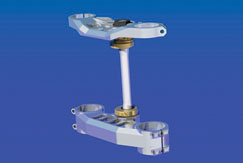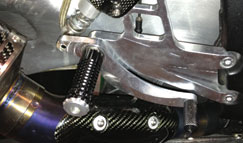Now in its 26th year, the Superbike World Championship (SBK) is an exhilarating event for both riders and spectators.

The PATA Honda World Supersport team races a Honda CBR600RR in the championship
Many of the big motorcycle manufacturers pit their production bikes against each other on various tracks around the world. These bikes are essentially modified street bikes enabling fans to identify themselves with the riders.
However, as with any sport involving a number of fast moving objects going round and round a track, there are bound to be a few bumps and prangs along the way.
For this reason, each team comes to a race with more than one bike per rider.
“We have two riders in the Superbike World Championship and to every race we bring four bikes, two for each rider,” explains Pieter Breddels, technical coordinator at Ten Kate Racing, which runs the Ten Kate PATA Honda team.
“We then also carry many parts with us to the races. For instance, we’ll bring five chassis, eight sets of fairings, 20 sets of rims and ten engines as well as many smaller spare parts such as clip-ons and foot rests. We bring all these parts so it is possible to rebuild four bikes from scratch if the worse comes to the worst.”
Dutch racing roots
Ten Kate is a motorcycle racing team based in Nieuwleusen, The Netherlands. Founded in 1993 it initially raced its bikes in regional Dutch road racing before entering the Supersport World Championship in 1999 and then the Superbike World Championship in 2004.
The PATA Honda team race a Honda CBR600RR (599cc engine) in the World Supersport Championship and a Honda CBR10000RR, also known as the Fireblade (999cc engine), in the Superbike World Championship.
“Unlike MotoGP, where purpose built machines are used and you can design your own chassis, Superbikes is more like touring car racing.
“We start from a street bike base, which means the chassis and engine have to be standard too. Of course you can tune the engine but the engine itself remains the same.
Everything else is different and you evolve the bike all the time,” explains Breddels.
Ten Kate used to rely on third party suppliers for parts or designed its own using outdated CAD software. However, in 2011 it formed a relationship with Siemens PLM Software and its engineers now use Solid Edge to design, calculate and analyse parts in-house.
“It’s been great to use this up-to-date package and not only do we get Solid Edge software but we also get the support through the Siemens reseller Bosch Engineering. Three of our in-house engineers have been to the training seminars and have learnt so many tricks to short cut their work.”
Fast development
The biggest advantage Ten Kate has found in using Solid Edge is that parts can be designed much quicker, drastically reducing development time.
“If we run into problems on a race then immediately when we are back in the office we can create new drawings of that part. In one week that part is produced and put on the bike for the next race. It may be quite straightforward parts but it’s done in a really short time,” says Breddels.
Throughout the race season Ten Kate may also have to design new parts.
It’s not a complete redesign of the bike but constantly small things are changed to fine tune the machine so that it performs better on race day.
“The bike is always developing, we are constantly designing new parts. It is mainly brackets but it can also be more complicated things like the fork yoke or foot pegs.”
Off season design
During the off season, Ten Kate can concentrate on the design of the more complex parts. For instance, this season the Honda bikes have had new electronics packages installed which has meant new parts having to be designed.
“The design of a new triple clamp, the part that attaches the fork tubes to the frame, is another example of a project we did during the winter months.
Our aim there has been to get the desired stiffness and thus front feel for the riders,” explains Breddels.
Of course one of the biggest challenges with the design of any superbike is to make it as light but as robust as possible to withstand crashes.
“The weight limit is 165kg for a superbike but it is quite hard to reach this. We are always over the limit by 3kg or 4kg so every part has to be as strong as possible but weigh very little.
This is the case with any development but especially with racing of course,” concludes Breddels.
tenkateracingproducts.com | patahonda.com
plm.automation.siemens.com
Ten Kate Racing keeps Honda superbikes on track with Siemens PLM software
Default








